Nypa palm, Mangrove Palm
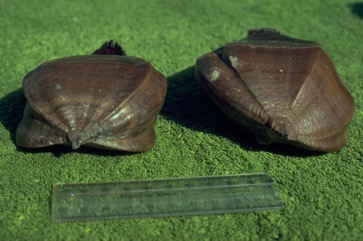
A tropical plant. It suits the hot wet tropical lowlands. They occur along tidal streams throughout the Philippines. They thrive in brackish swamps. They occur in tidal mud flats and mangroves. They occur naturally along the Papuan coast of Papua New Guinea but are most likely planted along the North coast.
Also known as:
Aian, Ayeng, Aying, Ayung, Chak, Dani, Fahsuc, Gabna, Ginpol, Golphal, Golpata, Golpatta, Gulga, Jahk, Kiya, Kiye, Kuwe, Nipah, Nipamu, Pardeshi-tadio, Pardeshitadio, Parem, Poothada, Rola, Teuechel, Touechel
Synonyms
- Nipa fruticans
Edible Portion
- Seeds, Sap, Shoots, Cabbage, Fruit
Where does Nypa palm grow?
Found in: Africa, Andamans, Asia, Australia, Bangladesh, Cambodia, China, Chuuk, Cuba, FSM, Guam, Guyana, India, Indochina, Indonesia, Japan, Kosrae, Malaysia, Micronesia, Myanmar, Nigeria, Pacific, Palau, Papua New Guinea, PNG, Philippines, Pohnpei, SE Asia, Solomon Islands, South America, Sri Lanka, Thailand, Vietnam, West Africa, Yap
Notes: There is only one Nypa species.
Status: The palm occurs near mangrove swamps and along the shoreline, in Papua New Guinea. The nut is used especially by children.
Growing Nypa palm, Mangrove Palm
Cultivation: Plants can be grown from seed. Plants can be grown by dividing off suckers. To get the sap to flow in the stalk, the stalk must be banged and shaken then the end cut off and trimmed daily. Tree densities of up to 2,500 palms per hectare occur but only 700-750 are sap producing. Plants are spaced at 1.5-1.7 m giving 390 per hectare where plantings occur. Plants are pollinated by insects therefore contact insecticides need to be avoided. To collect sap the almost full grown head is cut off. About 2 mm of the tip is removed each day during sap collection. Sap flow is increased by banging the trunk and tapping the fruit stalk regularly.
Edible Uses: The young kernel inside the nut is edible. It is normally eaten while immature. Also the base of the "nut" is chewed. Sugar (or vinegar) can be obtained by collecting the sap from the fruit stalk. The sap can be used as a coagulant for buffalo milk cheese. It can be boiled down to produce sugar. Young shoots are eaten.
Production: Palms flower and fruit after 3-5 years. Yields of sap of up to 1,500 ml of sap per day per palm over one month can be achieved. Tapping can occur for 50 years. Yields can be 87,000 litres of sap per hectare. Near Kerema in Papua New Guinea it flowers in May and fruits in July. The season is later in the Western Province.
Nutrition Info
per 100g edible portion| Edible Part | Energy (kcal) | Protein (g) | Iron (mg) | Vitamin A (ug) | Vitamin c (mg) | Zinc (mg) | % Water |
|---|---|---|---|---|---|---|---|
| Fruit - unripe | - | 1.6 | 0.4 | - | 2 | - | 88.9 |
| Shoots | 14 | 0.7 | 0.6 | - | 0 | 4.5 | 94.1 |
| Fruit - ripe | - | 4 | - | - | - | - | 35.7 |
Nypa palm, Mangrove Palm Photos

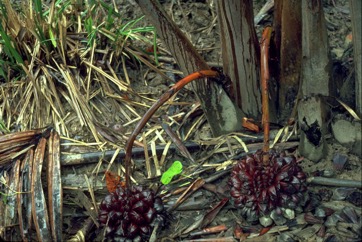
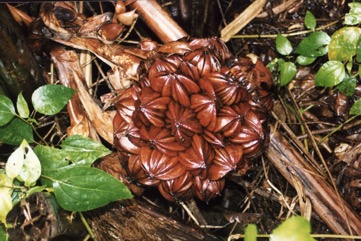
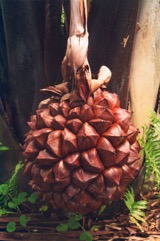
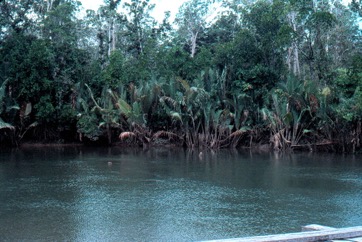
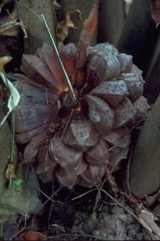
References
Ambasta, S.P. (Ed.), 2000, The Useful Plants of India. CSIR India. p 399, 402 (Also as Nipa)
Arora, K., Indigenous Forest Management in the Andaman and Nicobar Islands, India.
Arora, R. K., 2014, Diversity in Underutilized Plant Species - An Asia-Pacific Perspective. Bioversity International. p 106
Awasthi, A.K., 1991, Ethnobotanical studies of the Negrito Islanders of Andaman Islands, India - The Great Andamanese. Economic Botany 45(2) pp274-280
Baker, W.J. and Dransfield, J., 2006, Field Guide to Palms of New Guinea. Kew p 84
Balick, M.J. and Beck, H.T., (Ed.), 1990, Useful palms of the World. A Synoptic Bibliography. Colombia p 297, 374, 452, 466, 543,
BARC, 2016, State of Biodiversity for Food and Agriculture in Bangladesh. Bangladesh Agricultural Research Council.
Barfod, A.S., Banka R., and Dowe, J. L., 2001, Field Guide to Palms in Papua New Guinea. AAU Reports 40 Department of Systematic Botany University of Aarhus. Denmark. p 34
Barrau, J., 1976, Subsistence Agriculture in Melanesia. Bernice P. Bishop Museu, Bulletin 219 Honolulu Hawaii. Kraus reprint. p 53
Beasley, J., 2011, Plants of Tropical North Queensland - the compact guide. Footloose publications. p 17
Blomberry, A. & Rodd, T., 1982, Palms. An informative practical guide. Angus & Robertson. p 129
Borrell, O.W., 1989, An Annotated Checklist of the Flora of Kairiru Island, New Guinea. Marcellin College, Victoria Australia. p 38
Bourke, M., 1995, Edible Indigenous Nuts in Papua New Guinea. In South Pacific Indigenous Nuts. ACIAR Proceedings No 69, Canberra. p 46
Brock, J., 1993, Native Plants of Northern Australia, Reed. p 268
Burkill, H. M., 1985, The useful plants of west tropical Africa, Vol. 4. Kew.
Burkill, I.H., 1966, A Dictionary of the Economic Products of the Malay Peninsula. Ministry of Agriculture and Cooperatives, Kuala Lumpur, Malaysia. Vol 2 (I-Z) p 1582 (As Nipa fruticans)
Castillo, C., 2013, The Archaeobotany of Khao Sam Kaeo and Phu Khao Thong: The Agriculture of Late Prehistoric Southern Thailand. Ph. D. thesis University College, London p 379
Chau Sum, P., et al, 2013, Comparison of nutrient composition of ripe and unripe fruits of Nypa fruticans. Fruits, Vol 68, p. 491-498
Cooper, W. and Cooper, W., 2004, Fruits of the Australian Tropical Rainforest. Nokomis Editions, Victoria, Australia. p 74
Cribb, A.B. & J.W., 1976, Wild Food in Australia, Fontana. p 103
Cronin, L., 1989, The Concise Australian Flora. Reed. p 227
Cronin, L., 2000, Australian Palms, Ferns, Cycads and Pandans. Cronin Publications. p 60
Dobriyal, M. J. R. & Dobriyal, R., 2014, Non Wood Forest Produce an Option for Ethnic Food and Nutritional Security in India. Int. J. of Usuf. Mngt. 15(1):17-37
Elliot, W.R., & Jones, D.L., 1997, Encyclopedia of Australian Plants suitable for cultivation. Vol 7. Lothian. p 53
Facciola, S., 1998, Cornucopia 2: a Source Book of Edible Plants. Kampong Publications, p 162
French, B.R., 1986, Food Plants of Papua New Guinea, A Compendium. Asia Pacific Science Foundation p 191
French, B.R., 2010, Food Plants of Solomon Islands. A Compendium. Food Plants International Inc. p 195
Floyd, A.G., 1977, Ecology of the Tidal Forests in the Kikori-Romilly Sound Area Gulf of Papua. Ecology Report No 4 Division of Botany, Lae, Papua New Guinea. p 41
Gibbons, M., 1993, Palms. Compact study Guide and Identifier. Sandstone. p 56
Gibbons, M., 2003, A pocket guide to Palms. Chartwell Books. p 150
Hamilton, L. S. and Murphy, D. H., 1988, Use and Management of Nipa Palm (Nypa fruticans, Arecaceae): A Review. Economic Botany 42(2): 206-213
Haynes, J., & McLaughlin, J., 2000, Edible palms and Their Uses. University of Florida Fact sheet MCDE-00-50-1 p 10
Hedrick, U.P., 1919, (Ed.), Sturtevant's edible plants of the world. p 442 (As Nipa fruticans)
Hiddins, L., 1999, Explore Wild Australia with the Bush Tucker Man. Penguin Books/ABC Books. p 156
Hoe, V. B. & Siong, K. H., 1999, The nutritional value of indigenous fruit and vegetables in Sarawak. Asia Pacific J. Clin. Nutr. 8(1):24-31
Hosen, M. Z., et al, 2020, Comparison or Physicochemical and Antioxidant Properties of Edible Fruits in the Sundarbans' Mangrove Forest, Bangladesh. Bangladesh J. Bot. 49 (3): 671-678
Hu, Shiu-ying, 2005, Food Plants of China. The Chinese University Press. p 303
Johnson, D.V., 1998, Tropical palms. Non-wood Forest products 10. FAO Rome. p 42, 122
Jones, D.L., 1994, Palms throughout the World. Smithtonian Institution, Washington. p 275
Jones, D.L., 2000, Palms of Australia 3rd edition. Reed/New Holland. p 106
Kitalong, A. H., DeMeo, R. A., & Holm, T., 2013, A Field Guide to the Native Trees of Palau. 2nd edition. USDA p116
Kiple, K.F. & Ornelas, K.C., (eds), 2000, The Cambridge World History of Food. CUP p 1823
Lazarides, M. & Hince, B., 1993, Handbook of Economic Plants of Australia, CSIRO. p 173
Lovelock, C., & Clarke, S., 1999, Field Guide to the Mangroves of Queensland. Australian Institute of Marine Science. p 26
McMakin, P.D., 2000, Flowering Plants of Thailand. A Field Guide. White Lotus. p 79
Martin, F. W., et al, 1987, Perennial Edible Fruits of the Tropics. USDA Handbook 642 p 48
McClatchey, W. C., 2012, Wild food plants of Remote Oceania. Acta Societatis Botanicorum Poloniae 81(4) 371-380
Menninger, E.A., 1977, Edible Nuts of the World. Horticultural Books. Florida p 139
Monsalud, M.R., Tongacan, A.L., Lopez, F.R., & Lagrimas, M.Q., 1966, Edible Wild Plants in Philippine Forests. Philippine Journal of Science. p 523
Newcombe, K., Holmes, E.B. and Paivoke, A., 1980, Palm energy. Report No. 6/80 Energy Planning Unit. Dept. of Minerals and Energy. Konedobu, Papua New Guinea
Paivoke, A.E.A., Adams, M.R. and Peremai, M., 1982, The production of nipa palm vinegar in Papua New Guinea. Report No. 4/82 Energy Planning Unit, Department of Minerals and Energy. Konedobu, Papua New Guinea.
Pasha, M. K. & Uddin, S. B., 2019, Minor Edible Fruits of Bangladesh. Bangladesh J. Plant Taxon. 26(2): 299–313
Peekel, P.G., 1984, (Translation E.E.Henty), Flora of the Bismarck Archipelago for Naturalists, Division of Botany, Lae, PNG. p 65, 64
Phon, P., 2000, Plants used in Cambodia. © Pauline Dy Phon, Phnom Penh, Cambodia. p 471
Purseglove, J.W., 1972, Tropical Crops. Monocotyledons. Longmans p 427
Rajapaksha, U., 1998, Traditional Food Plants in Sri Lanka. HARTI, Sri Lanka. p 370
Rashid, H. E., 1977, Geography of Bangladesh. Westview. p 297 (As Nipa fruticans)
Riffle, R.L. & Craft, P., 2003, An Encyclopedia of Cultivated Palms. Timber Press. p 393
Roy, S. D., et al, 2009, Mangroves of Andaman and Nicobar Islands. ICAR p 33
Singh, H.B., Arora R.K.,1978, Wild edible Plants of India. Indian Council of Agricultural Research, New Delhi. p 67
Stone, B. C., 1970, The Flora of Guam. A Manual for the Identification of the Vascular Plants of the Island. Micronesica. Journal of the University of Guam. p 142
Sukarya, D. G., (Ed.) 2013, 3,500 Plant Species of the Botanic Gardens of Indonesia. LIPI p 797
Tiwi Plants and Animals. 2001, Aboriginal flora and fauna knowledge from Bathurst and Melville Islands, northern Australia. Northern Territory Botanical Bulletin; No. 24 p 69
Townsend, K., 1994, Across the Top. Gardening with Australian Plants in the tropics. Society for Growing Australian Plants, Townsville Branch Inc. p 305
Tucker, R., 1988, The Palms of Subequatorial Queensland. Palm and Cycad Society of Australia, Milton, Queensland. p 40
Verh. Batav. Genootsch. Kunsten 1:350. 1781
Wickens, G.E., 1995, Edible Nuts. FAO Non-wood forest products. FAO, Rome. p168
Williams, C.N., Chew, W.Y., and Rajaratnam, J.A., 1989, Tree and Field Crops of the Wetter Regions of the Tropics. Longman, p 180
World Checklist of Useful Plant Species 2020. Royal Botanic Gardens, Kew
www.manoa.hawaii.edu/botany/plants of micronesia.